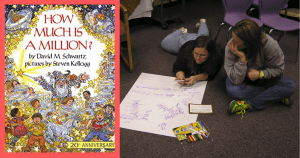We hear big numbers, like millions, billions and trillions, all the time, especially when talking about current events: There were roughly 36 million climate migrants in 2022. Global population will hit 10 billion in 2058. The U.S. debt is over 35 trillion dollars. I could go on and on.
Conceptualizing these big numbers is hard for children and grown-ups alike. When we hear such enormous quantities, our brains tend to put them all in a similar box of “a lot.” But by doing so, we lose the numbers’ significance – the difference between a million dollars and a billion dollars is ENORMOUS. Only when we really understand the scale of millions, billions, and trillions can we comprehend the reality behind what they are communicating.

This season, PopEd wants to help you teach these larger-than-life numbers. And in true PopEd fashion, we’ll be focusing on teaching large numbers in the context of real-world issues. Because while teaching about big numbers reinforces basic number sense and operations, it is also a critical piece in any study of global issues. To understand global challenges and ultimately, to fix them, we have to grasp the quantities behind the data.
Resources for Teaching Large Numbers
Follow along on socials (Facebook, LinkedIn, and X) to get all the resources we’ll be sharing in the coming weeks on big numbers. Use #PopEdBigNumbers to see all the content in one place!
- Join us for a free webinar, geared for grades 3-8 teachers. This interactive virtual workshop will provide hands-on activities for helping students visualize and estimate large numbers and for understanding the difference between a million and a billion.
- We’ll post lots of blogs that outline strategies and classroom tools for helping students make sense of the massive. From visual techniques to book recommendations, to where we can find big numbers in the real world, our blogs will provide support and ideas for teachers of all grades and subjects.

- We know the internet is full of tools and ideas. We also know it take lots of time to sort through it all to find what’s useful. So we’ll do the hard work! On our socials, we’ll post relevant articles, resource banks, and ideas from trusted sources for teaching about big numbers in your classroom.
Let’s Learn About Big Numbers!
We hope you’ll tuned and follow along. You may just learn something new (did you know that if you take 1 billion steps, you will circle the Earth over 11 times?!), and your students will thank you for bringing big numbers to life!
Image credit: Tokyo skyline (Zara Seemann, CC BY-SA 2.0 DE, via Wikimedia Commons)


